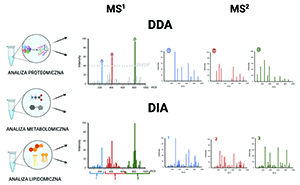Data-driven mass spectrometry methods (DDA) and data-independent methods (DIA) used in the analysis of biological material
DOI:
https://doi.org/10.18388/pb.2021_535Abstract
Mass spectrometry is an important tool in proteomic, metabolomic and lipidomic analysis. To fully use its potential, it is crucial to select and configure the appropriate analytical approach. For untargeted research, there are two main strategies available: data-dependent analysis (DDA) and data-independent analysis (DIA). Both methods differ in the way the analysis is carried out and in the degree of coverage of the obtained data, which is why each of them can be used in various types of research. The DDA method is based on continuous scanning of the analyzed ions, as a result of which the precursors with the highest intensity are fragmented in the MS2 mode. On the other hand, DIA, due to the use of combined ranges of precursor ion isolation, allows for a deeper analysis of the analyzed compounds. Both approaches also have modifications that improve their operation and enable obtaining more valuable data. Methods combining both techniques are also appearing on the horizon, such as DDIA, which uses the advantages of both methods, opening new analytical possibilities.

Published
License
Copyright (c) 2024 Marta Nolka-Szaszner, Aleksander Strugała, Łukasz Marczak

This work is licensed under a Creative Commons Attribution 4.0 International License.
All journal contents are distributed under the Creative Commons Attribution-ShareAlike 4.0 International (CC BY-SA 4.0) license. Everybody may use the content following terms: Attribution — You must give appropriate credit, provide a link to the license, and indicate if changes were made, ShareAlike — If you remix, transform, or build upon the material, you must distribute your contributions under the same license as the original. There are no additional restrictions — You may not apply legal terms or technological measures that legally restrict others from doing anything the license permits.
Copyright for all published papers © stays with the authors.
Copyright for the journal: © Polish Biochemical Society.



